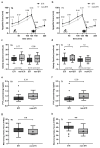A 3-Week Inpatient Rehabilitation Programme Improves Body Composition in People with Cystic Fibrosis with and Without Elexacaftor/Tezacaftor/Ivacaftor Therapy
- PMID: 40806025
- PMCID: PMC12348923
- DOI: 10.3390/nu17152439
A 3-Week Inpatient Rehabilitation Programme Improves Body Composition in People with Cystic Fibrosis with and Without Elexacaftor/Tezacaftor/Ivacaftor Therapy
Abstract
Background: The introduction of cystic fibrosis transmembrane conductance regulator modulators, especially the triple therapy elexacaftor, tezacaftor, ivacaftor (ETI), has improved outcomes in people with cystic fibrosis (pwCF), reducing underweight but increasing overweight rates.
Objectives: This study investigates the effect of ETI on appetite control, body composition, and energy balance during a 3-week inpatient rehabilitation programme with regular exercise.
Methods: In 54 pwCF (38 on ETI, 16 without ETI), changes in body composition (fat mass index, FMI; fat-free mass index, FFMI) and energy balance (calculated from body composition changes) were assessed. Appetite control was evaluated via plasma peptide YY (PYY) levels and post-exercise meal energy intake.
Results: The programme significantly increased BMI (+0.3 ± 0.1 kg/m2; CI 0.1-0.4) and energy balance (+4317 ± 1976 kcal/3 weeks), primarily through FFMI gains (+0.3 ± 0.1 kg/m2; CI 0.1-0.4). Despite higher post-exercise meal energy intake and a tendency towards lower PYY levels in the ETI group, changes in body composition and energy balance did not differ between groups. This is explained by a higher prevalence of exocrine pancreatic insufficiency in the ETI group (92% vs. 50%, p < 0.001). Small sample sizes limit the interpretation of data on appetite control and energy intake.
Conclusions: A 3-week inpatient rehabilitation programme improved body composition in pwCF, without resulting in a more positive energy balance with ETI therapy. This is due to a higher prevalence of pancreatic insufficiency in this group.
Keywords: CF rehabilitation; Elexacaftor/Tezacaftor/Ivacaftor; appetite control; body composition; energy balance; triple CFTR modulators.
Conflict of interest statement
The authors declare no conflicts of interest. The funders had no role in the design of the study; in the collection, analyses, or interpretation of data; in the writing of the manuscript; or in the decision to publish the results.
Figures


References
-
- Naehrlich L., Burkhart M., Basler C., Dittrich A.-M., Ellemunter H., Hebestreit H., Nitsche O., Held I., Smaczny C., Sutharsan S. German Cystic Fibrosis Registry-Annual Report 2023. Mukoviszidose e.V. & Mukoviszidose Institut GmbH; Bonn, Germany: 2024.
-
- European Medicines Agency Kalydeco. [(accessed on 9 July 2024)]. Available online: https://www.ema.europa.eu/en/medicines/human/EPAR/kalydeco#authorisation....
MeSH terms
Substances
Grants and funding
LinkOut - more resources
Full Text Sources
Medical

